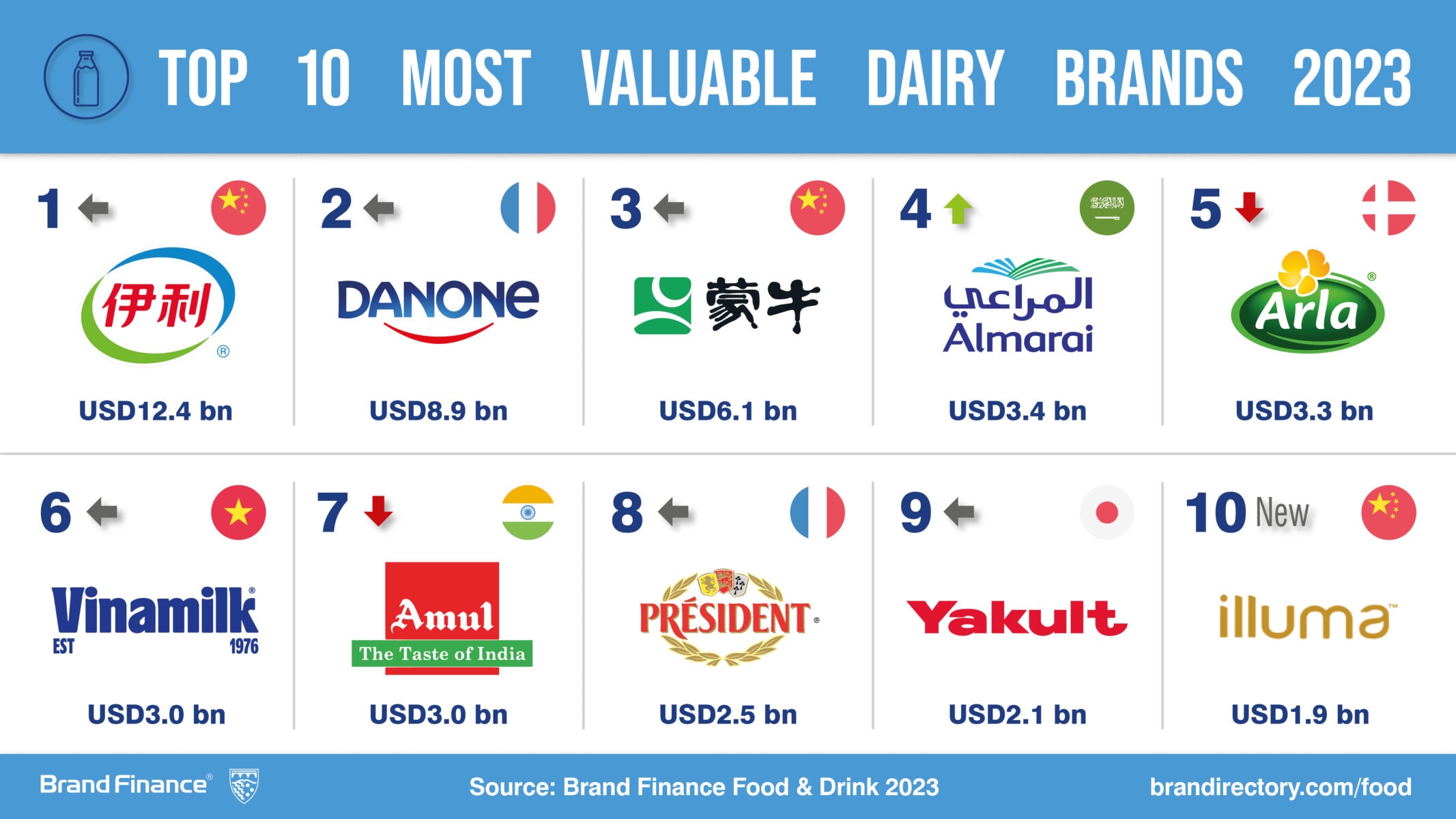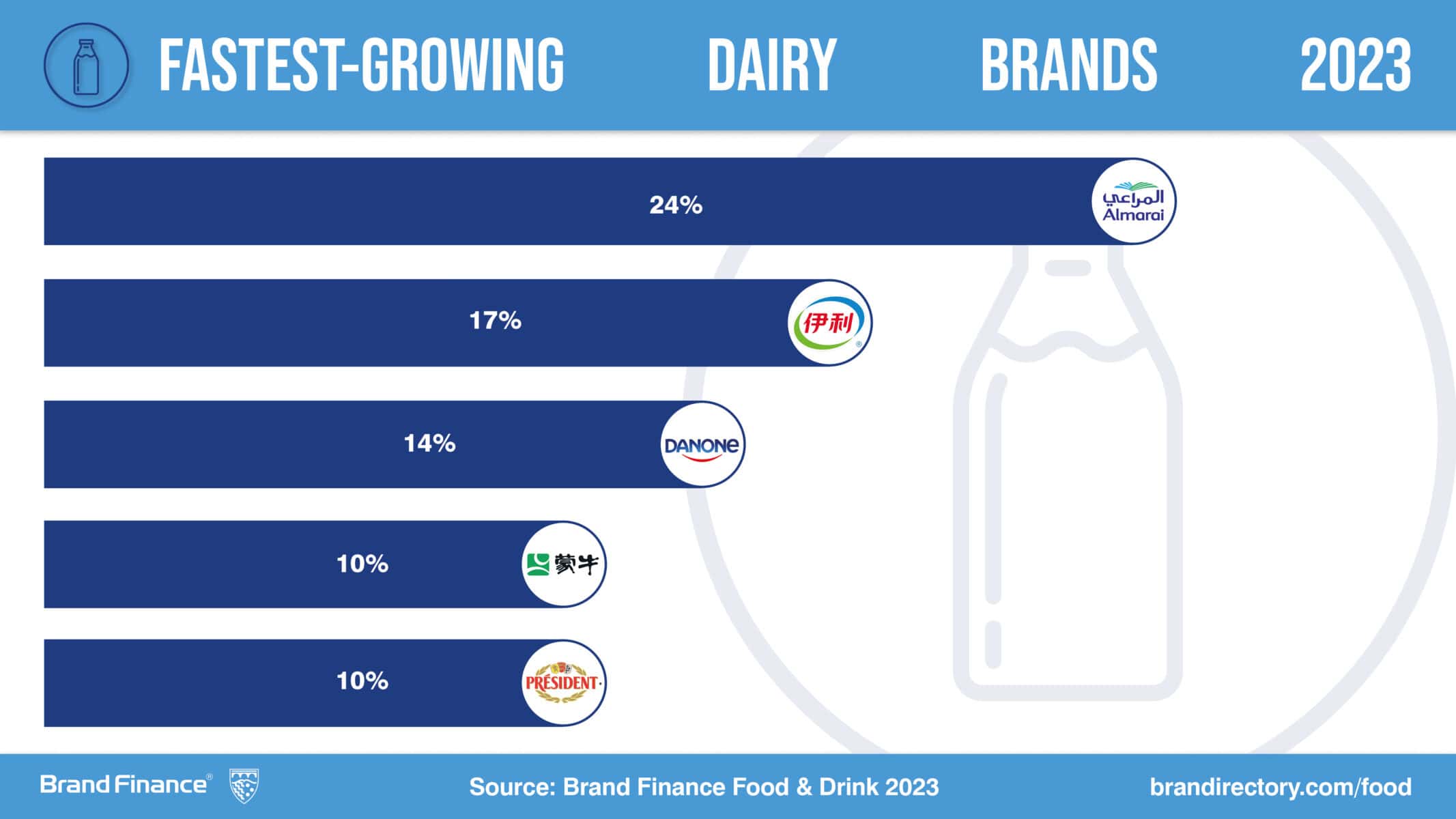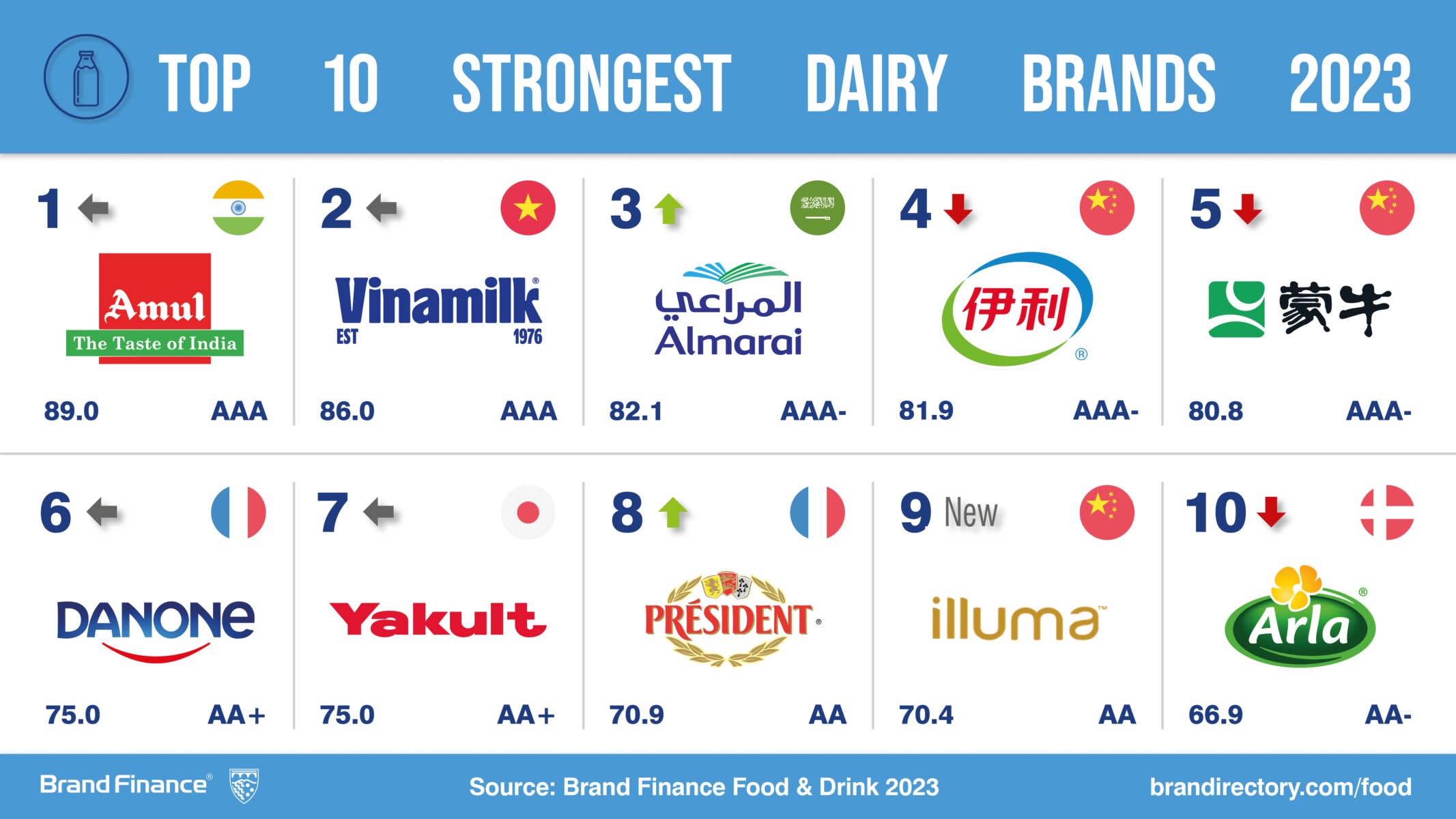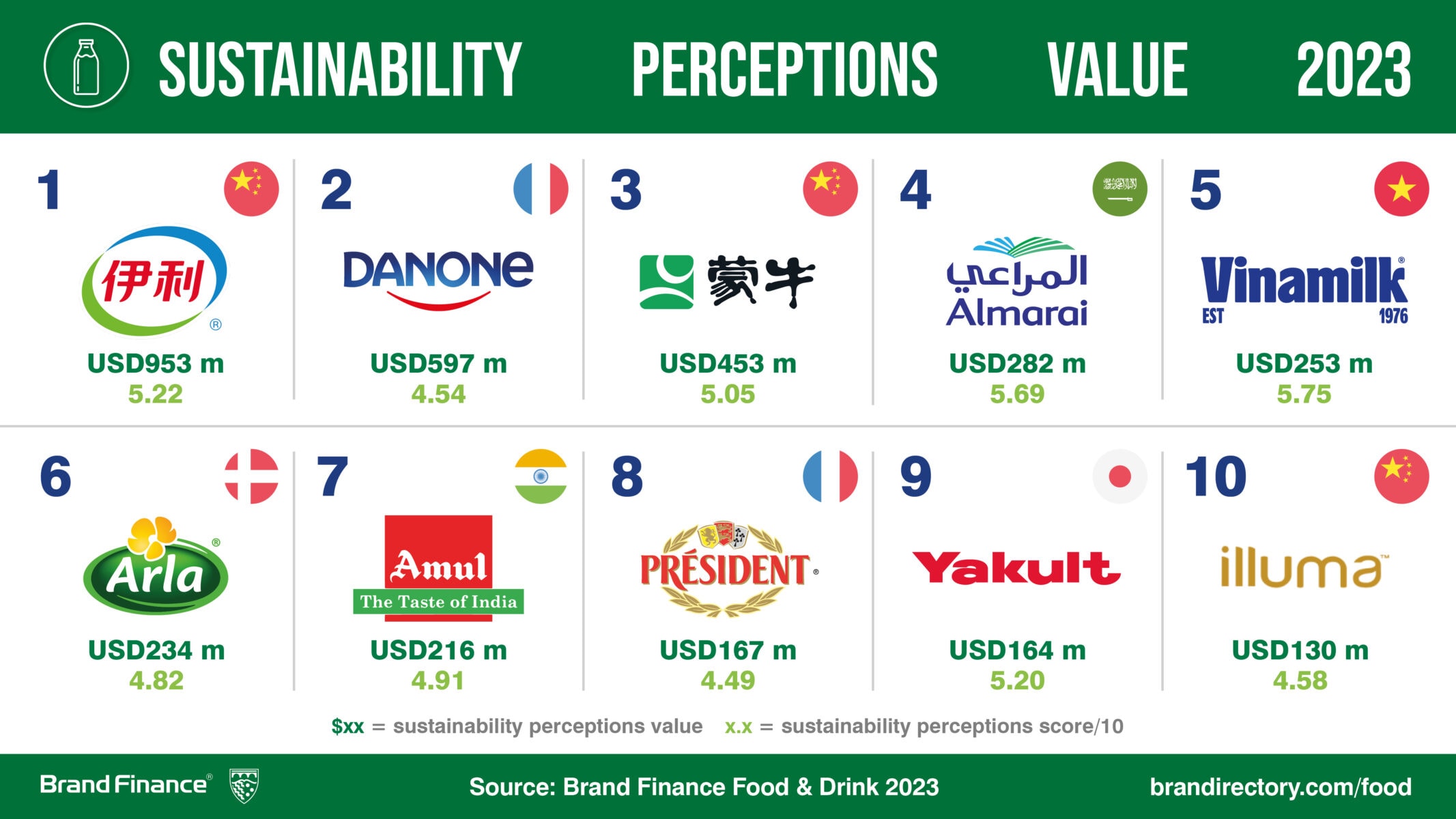View the full Brand Finance Food 100 2023 report here
Chinese brand Yili is the most valuable dairy brand in the world, valued at USD12.4 billion
Leading Chinese brand Yili (brand value up 17% to USD12.4 billion) earns title of world’s most valuable dairy brand, according to a new report from leading brand valuation consultancy, Brand Finance.
Every year, leading brand valuation consultancy Brand Finance puts 5,000 of the biggest brands to the test, and publishes over 100 reports, ranking brands across all sectors and countries. The world’s top 10 most valuable and strongest dairy brands are included in the annual Brand Finance Dairy 10 2023 ranking.
Yili has fostered strong customer loyalty in its local market by consistently delivering products of exceptional quality and perceived health benefits. This has contributed to strong domestic sales growth, while the brand’s global presence has also propelled its overseas revenue. Yili products are available in over 60 countries across five continents worldwide.
Scott Chen, Managing Director for Brand Finance China, commented,
“As China’s leading dairy brand, dairy innovation rests at the core of Yili’s business strategy. Through carrying out pioneering research and investing in cutting-edge technologies, the brand is continually expanding its versatile product range. Yili’s pursuit of innovation also goes together with a strong commitment to sustainable development; the brand is actively implementing environmental protection measures and leading the industry in its objective towards carbon neutrality.”

Almarai is fastest-growing dairy brand, brand value up 24%
This year’s fastest-growing dairy brand, Almarai (brand value up 24% to USD3.4 billion) enjoys strong familiarity levels in the Middle East, which has seen considerable demand for dairy products. Despite facing challenges in 2022, the brand’s resilience was an integral factor driving its growth. Almarai has continued to develop its marketing and expand its innovative product range, including launching its ready-to-drink teas, coffees and non-dairy milk, an ever-increasing option amongst consumers globally. The brand also remains committed to its social responsibility and environmental objectives, aligning with Saudi Vision 2030 and the United Nations Sustainable Development Goals.

Amul is this year’s strongest dairy brand, earning an AAA rating
In addition to calculating brand value, Brand Finance also determines the relative strength of brands through a balanced scorecard of metrics evaluating marketing investment, stakeholder equity, and business performance. Compliant with ISO 20671, Brand Finance’s assessment of stakeholder equity incorporates original market research data from over 100,000 respondents in 38 countries and across 31 sectors.
This year’s strongest dairy brand Amul (brand value down 8% to USD3 billion) also ranked as India’s most valuable food and drinks brand, where it continues to enjoy immense familiarity, popularity, and success. Amul is known for producing a versatile range of innovative and high-quality dairy products, while its competitive pricing strategy means its products are affordable and accessible to a large population. Amul has also fostered exceptionally strong brand loyalty amongst its wide consumer base; its effective and memorable marketing is deep-rooted in Indian culture and heritage, while its successful endeavours in digital marketing have allowed the brand to stay ahead of competitors.

Yili has the highest Sustainability Perceptions Value, at USD953 million
Yili has the highest Sustainability Perceptions Value of any brand included in the 2023 Dairy 10 ranking, at USD953 million. It should be noted that the brand’s position at the top of the SPV table is not an assessment of its overall sustainability performance, but rather indicates how much brand value it has tied up in sustainability perceptions.
Yili has demonstrated its unwavering commitment to sustainability with its active participation in the United Nations’ initiatives and programmes. This year, the brand completed the United Nations Global Compact (UNGC)‘s Climate Ambition Accelerator (CAA) Programme. During the closing ceremony dialogue in Shanghai, Yili shared about how its carbon neutrality progress had picked up pace, owing to the programme’s support.
By the end of 2022, 31 Yili factories had been certified as state-level “green factories”. In addition, at the UN 2023 Water Conference in New York, Yili proposed its Low Water Footprint Initiative for the dairy industry – making Yili China’s first company to join the UN Water Action Agenda. This initiative aims to extend the company’s best practices globally to reduce water footprints through cross-sectoral cooperation and synergies.

Brand Finance is the world’s leading brand valuation consultancy. Bridging the gap between marketing and finance, Brand Finance evaluates the strength of brands and quantifies their financial value to help organisations make strategic decisions.
Headquartered in London, Brand Finance operates in over 25 countries. Every year, Brand Finance conducts more than 6,000 brand valuations, supported by original market research, and publishes over 100 reports which rank brands across all sectors and countries.
Brand Finance also operates the Global Brand Equity Monitor, conducting original market research annually on 6,000 brands, surveying more than 175,000 respondents across 41 countries and 31 industry sectors. By combining perceptual data from the Global Brand Equity Monitor with data from its valuation database — the largest brand value database in the world — Brand Finance equips ambitious brand leaders with the data, analytics, and the strategic guidance they need to enhance brand and business value.
In addition to calculating brand value, Brand Finance also determines the relative strength of brands through a balanced scorecard of metrics evaluating marketing investment, stakeholder equity, and business performance, compliant with ISO 20671.
Brand Finance is a regulated accountancy firm and a committed leader in the standardisation of the brand valuation industry. Brand Finance was the first to be certified by independent auditors as compliant with both ISO 10668 and ISO 20671 and has received the official endorsement of the Marketing Accountability Standards Board (MASB) in the United States.
Brand is defined as a marketing-related intangible asset including, but not limited to, names, terms, signs, symbols, logos, and designs, intended to identify goods, services, or entities, creating distinctive images and associations in the minds of stakeholders, thereby generating economic benefits.
Brand strength is the efficacy of a brand’s performance on intangible measures relative to its competitors. Brand Finance evaluates brand strength in a process compliant with ISO 20671, looking at Marketing Investment, Stakeholder Equity, and the impact of those on Business Performance. The data used is derived from Brand Finance’s proprietary market research programme and from publicly available sources.
Each brand is assigned a Brand Strength Index (BSI) score out of 100, which feeds into the brand value calculation. Based on the score, each brand is assigned a corresponding Brand Rating up to AAA+ in a format similar to a credit rating.
Brand Finance calculates the values of brands in its rankings using the Royalty Relief approach – a brand valuation method compliant with the industry standards set in ISO 10668. It involves estimating the likely future revenues that are attributable to a brand by calculating a royalty rate that would be charged for its use, to arrive at a ‘brand value’ understood as a net economic benefit that a brand owner would achieve by licensing the brand in the open market.
The steps in this process are as follows:
1 Calculate brand strength using a balanced scorecard of metrics assessing Marketing Investment, Stakeholder Equity, and Business Performance. Brand strength is expressed as a Brand Strength Index (BSI) score on a scale of 0 to 100.
2 Determine royalty range for each industry, reflecting the importance of brand to purchasing decisions. In luxury, the maximum percentage is high, while in extractive industry, where goods are often commoditised, it is lower. This is done by reviewing comparable licensing agreements sourced from Brand Finance’s extensive database.
3 Calculate royalty rate. The BSI score is applied to the royalty range to arrive at a royalty rate. For example, if the royalty range in a sector is 0-5% and a brand has a BSI score of 80 out of 100, then an appropriate royalty rate for the use of this brand in the given sector will be 4%.
4 Determine brand-specific revenues by estimating a proportion of parent company revenues attributable to a brand.
5 Determine forecast revenues using a function of historic revenues, equity analyst forecasts, and economic growth rates.
6 Apply the royalty rate to the forecast revenues to derive brand revenues.
7 Discount post-tax brand revenues to a net present value which equals the brand value.
Brand Finance has produced this study with an independent and unbiased analysis. The values derived and opinions presented in this study are based on publicly available information and certain assumptions that Brand Finance used where such data was deficient or unclear. Brand Finance accepts no responsibility and will not be liable in the event that the publicly available information relied upon is subsequently found to be inaccurate. The opinions and financial analysis expressed in the study are not to be construed as providing investment or business advice. Brand Finance does not intend the study to be relied upon for any reason and excludes all liability to any body, government, or organisation.
The data presented in this study form part of Brand Finance's proprietary database, are provided for the benefit of the media, and are not to be used in part or in full for any commercial or technical purpose without written permission from Brand Finance.